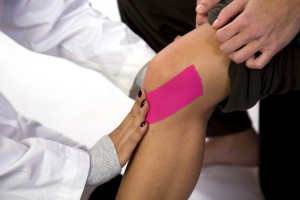
Have you noticed on the fantastic TV coverage of the London Olympics 2012 that many of the athletes have medical tape applied directly to their skin. The Dutch women beach volleyball players even had designer tape and the water-polo team must have had waterproof tape. When I was a young Elf in the mid 80s I remember the popularity of the McConnell technique and the introduction of application of tape for anterior knee pain. My Musculoskeletal Elf colleagues inform me that tape is still a relatively inexpensive intervention and is in frequent use in clinical practice. This left me wondering how effective tape actually is for musculoskeletal conditions.

Tape is still a relatively inexpensive intervention and is in frequent use in clinical practice.
As we discovered in an earlier blog, DATE, patellofemoral pain syndrome is common in runners. It is also estimated that 25% of people will suffer anterior knee pain at some point. So it was with interest that I noticed a Cochrane review authored by some nice chaps in the UK who coincidentally I worked with in the old days. They assessed the effects, primarily on pain and function, of patellar taping for treating patellofemoral pain syndrome in adults.
Here’s what they did
The authors, from the UK, undertook a comprehensive search of databases up to August 2011. They searched for randomised controlled and quasi-randomised controlled trials comparing taping versus control (no or placebo taping). They excluded trails that investigated the immediate effects of taping focusing instead on longer team effects. They found five small trails involving approximately 200 participants and 216 knees. They assessed risk of bias using the Cochrane Collaborations ‘risk of bias tool’.
Here’s what they found
- All trails included one or more co-interventions given to all participants, this was prescribed exercise in four trials.
- The intensity and length of treatment was very varied from one week to three months.
- There was no difference in pain scores, visual analogue scale (VAS), from four trials (data from 161 knees) at the end of the treatment programmes (mean difference -0.15; 95% CI -1.15 to 0.851)
- Data for other outcomes measuring function and activities of daily living were from single trials only and gave contradictory results.
The Musculoskeletal Elf’s thoughts
 Although the immediate effects of tape for patellofemoral pain syndrome have been established it appears from this review that longer term outcomes particularly pain are questionable. The findings of this review are hindered due to heterogeneity of the included studies. This included lack of a consistent definition of patellofemoral pain syndrome, the duration of the condition and the type of tape (elastic or rigid), the direction of pull of the tape (medial, lateral, inferior, superior, rotational, or no directional pull at all) and the number of layers of tape. Furthermore the quality of the included trails was low due to small samples sizes and high risk of bias. Of course there are also many other biomechanical factors contributing to this condition. However if taping is effective it would be an inexpensive intervention and physiotherapists could teach patients to tape themselves.
Although the immediate effects of tape for patellofemoral pain syndrome have been established it appears from this review that longer term outcomes particularly pain are questionable. The findings of this review are hindered due to heterogeneity of the included studies. This included lack of a consistent definition of patellofemoral pain syndrome, the duration of the condition and the type of tape (elastic or rigid), the direction of pull of the tape (medial, lateral, inferior, superior, rotational, or no directional pull at all) and the number of layers of tape. Furthermore the quality of the included trails was low due to small samples sizes and high risk of bias. Of course there are also many other biomechanical factors contributing to this condition. However if taping is effective it would be an inexpensive intervention and physiotherapists could teach patients to tape themselves.

The Musculoskeletal Elf’s call to action: agree a clear definition of patellofemoral pain and develop high quality trails to test the effectiveness of taping.
So here is The Musculoskeletal Elf’s call to action…..are you up for it? Let us know. As most physiotherapists are trained in taping I encourage all you musculoskeletal gurus out there get to together and agree a clear definition for patellofemoral pain syndrome and plan a high quality large scale clinical trial that tests the effects of different types and durations of taping on longer term outcomes of importance to patients.
Do you use taping for patellofemoral pain syndrome or other musculoskeletal conditions? What is your view on this review, will it change your clinical practice? Send us your views on this blog and become part of the Musculoskeletal Elf community.
Links
- Callaghan MJ, Selfe J. Patellar taping for patellofemoral pain syndrome in adults. Cochrane Database of Systematic Reviews 2012, Issue 4. Art. No.: CD006717. DOI: 10.1002/14651858.CD006717.pub2.

Very interesting summary. Taping definitely seems to have its place as a method of pain intervention. At the end of this we may still be left with perpetuating biomechanical issues up and down the kinetic chain. Whether the athlete / client might have a forefoot varus encouraging the lower limb into a greater proportion of the gait cycle in pronation; or from the hip perhaps there are issues of quadricep dominance or gluteal weakness forcing an inefficient movement pattern (valgus knee drift anyone ?). Maybe if the movement pattern remains un-addressed this might partly explain the poorer long term outcome ?
My thoughts on taping are that I use it to manage anterior knee pain in order to strengthen VMO (usually). Works well, patients easily learn how to apply it themselves and usually progress quickly and are free of it within a couple of sessions. All other biomechanical challenges have to be addressed too to prevent recurrence.
For those of you who would like more of the latest information on patellofemoral research I would suggest looking at
Patellofemoral Pain: Proximal, Distal, and Local Factors, 2nd International Research Retreat, Het Pand, Ghent, Belgium. Christopher M. Powers, Lori A. Bolgla, Michael J. Callaghan, Natalie Collins, Frances T. Sheehan. J Orthop Sports Phys Ther 2012;42(6):A1-A54.
and
Patellofemoral Pain Syndrome: Proximal, Distal, and Local Factors, An International Retreat, April 30-May 2, 2009, Fells Point, Baltimore, MD, USA. Irene S. Davis, Christopher M. Powers. J Orthop Sports Phys Ther 2010;40(3):A1-A48.
The mission of these 2 International Patellofemoral Pain Research Retreats was to bring together scientists and clinicians from around the world who are conducting research aimed at understanding the factors that contribute to the development and, consequently, the treatment of PFP. The format of the retreats included keynote presentations, interspersed with podium and poster sessions. An important element of the retreats was the development of consensus statements that summarized the state of the research in each of the 4 presentation categories (Interventions, Proximal, Distal, and Local Factors).